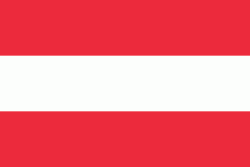Hirtenberg
Hirtenberg is a town of approx. 2,500 inhabitants near Baden bei Wien in Lower Austria, Austria. The river Triesting is located at the south border of the town. Coming from the Vienna Woods, the valley of Triesting joins the Vienna Basin here.
Starting in the east going clockwise the following towns are located next to Hirtenberg:
* Leobersdorf
* Enzesfeld-Lindabrunn
* St. Veit an der Triesting (part of Berndorf)
Starting in the east going clockwise the following towns are located next to Hirtenberg:
* Leobersdorf
* Enzesfeld-Lindabrunn
* St. Veit an der Triesting (part of Berndorf)
Map - Hirtenberg
Map
Country - Austria
 |
 |
| Flag of Austria | |
Austria emerged from the remnants of the Eastern and Hungarian March at the end of the first millennium. Originally a margraviate of Bavaria, it developed into a duchy of the Holy Roman Empire in 1156 and was later made an archduchy in 1453. In the 16th century, Vienna began serving as the empire's administrative capital and Austria thus became the heartland of the Habsburg monarchy. After the dissolution of the Holy Roman Empire in 1806, Austria established its own empire, which became a great power and the dominant member of the German Confederation. The empire's defeat in the Austro-Prussian War of 1866 led to the end of the Confederation and paved the way for the establishment of Austria-Hungary a year later.
Currency / Language
| ISO | Currency | Symbol | Significant figures |
|---|---|---|---|
| EUR | Euro | € | 2 |
| ISO | Language |
|---|---|
| HR | Croatian language |
| DE | German language |
| HU | Hungarian language |
| SL | Slovene language |
















